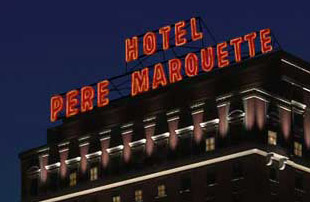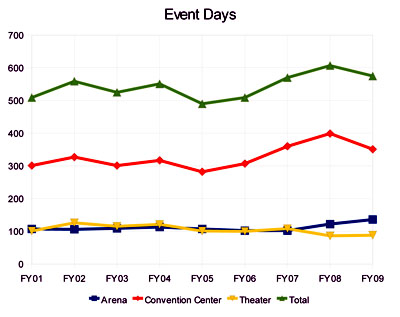 At the request of come commenters, I’ve been trying to get information on what’s new with the Wonderful Development. As far as I can tell, nothing.
At the request of come commenters, I’ve been trying to get information on what’s new with the Wonderful Development. As far as I can tell, nothing.
The City Council initially approved (by a 10-1 vote) an agreement in December 2008 with EM Properties to redevelop the Pere Marquette block, upgrading the Pere and building a pedestrian bridge across Fulton St. to the Civic Center. EM Properties couldn’t fulfill that agreement, so they came back in May 2010 requesting a new redevelopment agreement that was significantly different than the first one. The new agreement would have two hotels instead of one (i.e., they would still restore the Pere and make it a four-star Marriott, but would also build a separate Courtyard by Marriott on the block), and fewer rooms overall. They also requested $37 million instead of $39 million in bonds (i.e., taxpayer subsidy). At the time, the City reported on their Council Communication, “EM Properties has made modifications to their project and has now secured all necessary private financing.” The new redevelopment agreement was approved by a 7-4 vote.
The agreement required in section 3.3, “No later than ninety (90) days after the execution of this Agreement, the Redeveloper shall submit to the City the Design Concept Plan for the Project which Design Concept Plan shall contain the Exterior Architectural Appearance of the Project.” And in section 3.5, “No later than August 1, 2010, the Redeveloper shall submit to the City Schematic Drawings developed in connection with the design-build contract for the Project.” So, I asked the City, via a Freedom of Information Act request, when these documents were submitted.
Well, I didn’t find out exactly when they were submitted. All I received was a letter dated September 10, 2010, from the City’s Corporation Counsel Randy Ray to EM Properties, Ltd., that said:
This letter will confirm that your booklet entitled “Downtown Peoria Mariott Hotel Project — Hotel Site Plans” containing drawings dated May 3, 2010, satisfies the requirements of Section 3.5 of the Redevelopment Agreement between the City of Peoria and EM Properties, Ltd. concerning schematic drawings.
We would take this oportunity to remind you that in order to get a building permit for the Project, the Inspections Department will need professionally sealed construction documents.
Thank you for your cooperation in this matter.
In a follow-up phone call to Randy Ray, he stated that the booklet also included the Design Concept Plan and thus satisfied section 3.3 of the redevelopment agreement as well. However, section 3.4 of the agreement states, “The City shall within thirty (30) days from receipt approve or disapprove the Design Concept Plan.” And for the purposes of that section, the “City” means the City Council. Mr. Ray confirmed that the design concept plan has never come before the City Council, and said he will try to get it on the Council’s agenda in November. He thanked me for bringing it to his attention.
Meanwhile, you may recall that EM Properties was trying to get moral obligation financing through the Illinois Finance Authority to “finance a portion of the energy efficient upgrades of the 270-room historic Pere Marquette Hotel that will be renovated and converted to a Marriott and a ‘to be’ constructed 180-room Courtyard.” They had a big public hearing on it in March 2010. The last I heard about it was in May when the Journal Star reported, “EM Properties, the developer of the Marriott Hotel project, needs approval from the Illinois Finance Authority. The authority next meets June 8, and it’s unknown whether a request for a moral obligation bond supporting the hotel will be on the agenda.”
Well, it wasn’t on the agenda in June. In fact, it’s never again appeared on an IFA agenda. However, there are some related matters on the IFA slate. In August 2006, the current owners of the hotel, Pere Marquette Hotel Associates, L.P., entered into a participation loan with the IFA and National City Bank (now PNC). That loan should have been paid off March 31, 2010, but because of the pending sale to EM Properties, there was a request to extend the final maturity date until June 30. However, the sale didn’t close by then, so another extension was approved until September 30. The sale had not closed as of September 30 because a third extension was requested at the October 12 IFA meeting:
This is a third request by PNC Bank, and the Borrower, to extend the final maturity date beyond the originally scheduled March 31, 2010, maturity date in anticipation of the sale of the Hotel Pere` Marquette to EM Properties.
This request will provide an additional 120-day window for Pere` Marquette Hotel Associates, L.P. to close on the sale of the hotel property to EM Properties, LLC. Again, PNC and the other lenders expect this purchase to close by November 30, 2010.
Despite the expectation that the sale will close by the end of November, the extension goes through January 31, 2011.
I’m not sure what all this means, but I have to say these delays are awfully strange for a project that supposedly had “secured all necessary private financing” back in May.




